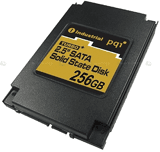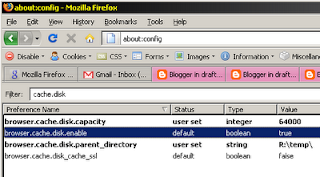 In my previous post I talked about why more Hard Drives are better than one.
In my previous post I talked about why more Hard Drives are better than one.Today, I'll show you how to tune your system so you can reap the benefits.
First of all, if you're planning to use more than a single HD, you'll need to carefully consider how you're going to use your computer and what you're trying to achieve. There are so many different variables that finding a "perfect" setup is - quite frankly - impossible.
So, let's assume a generic use scenario, without any special requirements for particular software applications.
For instance, in my case, in a 2 HD scenario I would split things as follows:
HD #1 I would create 2 partitions on it.
Partition #1 (10-20% of total disk space) would hold the OS and frequently used Applications.
Partition #2 (80-90% of disk space) would hold larger applications like games and other stuff that we're more likely to install/remove frequently.
HD #2 I would also create 2 partitions here.
Partition #1 (smaller) This is where you would setup the paging file (if needed,) and also setup to be used as "temporary" storage.
Partition #2 (largest) For all your documents, media, music, movies, etc. (You could create more partitions to keep your things separate if you have large collections of those - as in a partition for movies, other for music, other for downloads, etc.)
You could also set aside a separate partition to temporarily download highly fragmented files such as the ones you get via bittorrent.
So if we had two 500GB HDs:
I would set it up like this:
C: Disk #1 Partition #1 - size 80GB (for Windows XP + often used programs)
D: Disk #2 Partition #1 - size 10GB (For paging file + temporary files. If you usually work with larger files - as in multigigabyte compressed files -, you should increase its size accordingly)
E: Disk #1 Partition #2 - size 420GB (for large programs, such as games, as well as keeping a backup of more important stuff also stored in F:)
F: Disk #2 Partition #2 - size 490GB (Your main storage space, for all your docs, movies, music, etc.)
Ideally, if you ever need to migrate to a new computer, F: should hold all important stuff you'll ever need to backup and restore - the rest is just stuff you can install again.
So, let's start by telling Windows to use a different temporary location for all its stuff.
Windows XP (and Vista) store this location in a place reminiscent from the old MS-DOS days: the environment variables.
Just check it out - open a command prompt and type SET followed by Enter.
You'll get a list of all the the environment variables in use.
From all of those, we're only interested in two:
TEMP=C:\DOCUME~1\Carlos\LOCALS~1\Temp
TMP=C:\DOCUME~1\Carlos\LOCALS~1\Temp
(Your will be slightly different, according to your user name.)
The reason there are two comes from way back, when some programs used TEMP and others used TMP to determine that location.
You can also see all the junk you have there by clicking on the start button->Run and entering %TEMP%
You'll be taken to that location and find hundreds (or thousands) of temporary files.
So, we'll need to edit those and point them to the new place; in our case D:\TEMP
Note: You should always use a subfolder for your temporary location. Don't ever place it on the root folder as it can cause problems with some programs. Besides, it's tidier to have it all under a "Temp" folder anyway... One you can easily clean up at boot for instance.
FAT32 file systems also have a limit on the maximum number of files you can have on the root folder. Placing in in a subfolder removes that limitation.
You'll need to right click on your computer icon, goto properties and click advanced.
Then you need to click on the Environment Variables button near the bottom to get to this window.
This is where you can edit/insert the environment variables you saw earlier on the command prompt.
(images courtesy of ask-leo)
Make sure you edit/add both the TMP and TEMP environment variables and set them to the right location - in our case: D:\TEMP
This takes care of Windows, but now you must do the same for your browser as well.
For Internet Explorer you can do this in Tools->Internet Options:
Then you go to Temporary Files Settings->Move Folder-> and choose your new location.
In our case you could point it to D:\TEMPNET
(You should also restrict its size according to the available disk space on D - this particularly important if you're using a smaller RAM disk.)
If you're using Firefox then you need to type about:config in the url input box and then search for:
browser.cache.disk
You'll need to edit the location of:
browser.cache.disk.parent_directory
And you can also set a maximum size in:
browser.cache.disk.capacity
You can/should check all other programs you use frequently to see if you there are options to manually set its temporary files location. Programs like Winzip and similars often allow you to do that.
[To be continued...]
In the next part we'll see the particularities of using a SSD, with its unique features that render most currently HD improving techniques such as caching and pre-fetching useless, and learn how to use it best.











Having TEMP files and User files on a separate drive is great. But many applications store their data under user profile, in particular in the "Application Data" directory.
ReplyDeleteI'd rather mount "Document And Settings" on the HD drive instead of SSD. This is easy to do when you install WinXp (read http://support.microsoft.com/kb/314843/). But a bit harder if your system is already installed.
@Igorek
ReplyDeleteYes, that's one of the options as well. Thanks for pointing that out.